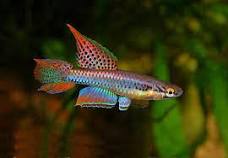Aphyosemion bivittatum, often simply referred to as F. bivittatus, is a captivating species of killifish native to the West African region, specifically found in the border areas of southeastern Nigeria and southwestern Cameroon. These small, ornamental fish are renowned among aquarium enthusiasts for their vibrant colors, unique behaviors, and relatively manageable size, making them an attractive choice for hobbyists looking to establish and maintain beautiful aquatic environments.

Physical Characteristics and Sexual Dimorphism
One of the most striking features of Aphyosemion bivittatum is the pronounced sexual dimorphism exhibited by the species. Males, in particular, showcase a stunning array of colors and patterns, with their bodies adorned in vivid hues that capture the attention of any observer. A distinguishing feature of the male Aphyosemion bivittatum is the elongated tail fin, which extends both at the top and bottom, forming an eye-catching pointed shape. In contrast, female Aphyosemion bivittatum are less colorful and lack the elongated tail fins seen in males, exhibiting a more subdued appearance.
Social Behavior and Interaction
In the realm of social behavior, Aphyosemion bivittatum is known for its intriguing dynamics. These fish are remarkably active swimmers, constantly exploring their aquatic surroundings. While they are generally considered peaceful, there is a notable caveat regarding territoriality, predominantly observed in male individuals. Male A. bivittatum often exhibit a strong territorial instinct, staking claim to specific areas within their habitat. However, it is worth noting that these territorial displays rarely result in harm to other fish, especially females.
Habitat Requirements
The successful care and maintenance of Aphyosemion bivittatum in captivity hinge on understanding and providing for their specific habitat requirements. These fish thrive in environments with clear water that is low in infusoria and bacteria. Ensuring water quality and clarity is paramount to their well-being. Additionally, the positioning of the aquarium plays a pivotal role in their care. Aphyosemion bivittatum prefer a shaded location that shields them from direct sunlight. This choice of placement replicates their natural habitat conditions, helping to maintain their health and vitality.
Breeding Considerations
For enthusiasts interested in breeding Aphyosemion bivittatum, attention to specific temperature parameters is crucial. The ideal breeding temperature typically falls within the range of 24-26 degrees Celsius. Maintaining these conditions promotes successful reproduction and the development of offspring. Breeding Aphyosemion bivittatum can be a rewarding experience for aquarium hobbyists, as it allows for a deeper understanding of their life cycle and behavior.
Dietary Preferences
The dietary preferences of Aphyosemion bivittatum are relatively specialized. These fish primarily consume live food, which includes organisms such as Daphnia and Cyclops, aquatic insect larvae, enchytraeids (small, white worms), and small earthworms. Providing a suitable diet is essential for their growth, overall health, and vitality. As carnivorous species, their nutritional requirements are met through these live food sources.
Size and Tank Recommendations
Aphyosemion bivittatum are small fish, with an adult size that typically reaches up to about 5 centimeters (2 inches). Given their size, they are well-suited for aquariums of modest dimensions. A recommended tank length for housing these fish is approximately 60 centimeters (24 inches). This sizing guideline allows for their active swimming behavior and provides adequate space for their well-being.
In conclusion, Aphyosemion bivittatum is a captivating species of killifish that has earned a place of distinction in the hearts of aquarium enthusiasts. Their striking appearance, intriguing social behavior, and specific care requirements make them a rewarding addition to freshwater aquariums. By understanding their unique characteristics and providing the appropriate conditions, hobbyists can create thriving aquatic ecosystems that showcase the vibrant beauty of F. bivittatus, bringing a touch of West Africa’s aquatic wonder into their homes.